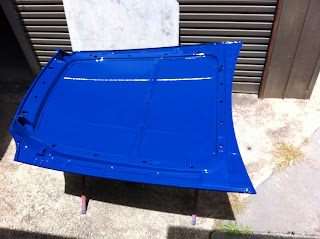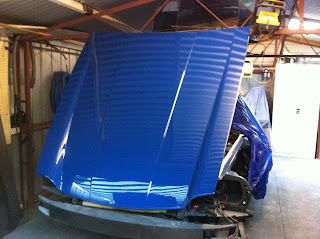It was time to really get the interior moving. My materials arrived from the US (Australia has a very limited selection of upholstery supplies, that is, if you don't want to choose from the same half dozen colours that everyone else has in their car), and I wanted something quite specific.
All the carpet has been cut and the tunnel and sills have had their carpet glued in place. The floor mats need a final trim then I'll bind them. I really like the carpet, the colour suits the era of the car:
It was also time to close up the C pillar covers and fresh air vents. My fresh air vents had cracked and split, just like every other XJS out there, and were definitely leaking water. These pieces really contribute to rust on the XJS, as the water runs directly into the boot, quarter panel and rear jack point when they leak.
A local supplier had one listed as an XJS quarter panel vent on Ebay, but inexplicably, had the other side listed as a really vaguely titled auction on Ebay, just listing the part number, which was hard to track down.
Long story short, I now had two brand new C pillar vents for under $50:
Now, the pillar vent issues don't end with them being old and cracking. I have now removed four of these vents off two cars and not one of them was sealed to the body properly. Another huge problem is that the vents are made of several pieces, and where these pieces join at the bottom, there is a gap. A gap right where any water trapped by these vents runs past!
I can guarantee that if your C pillar trims are original and have never been removed, they are leaking....I made sure my ones were well sealed with butyl mastic.
A long while ago, I scored a NOS C pillar trim on Ebay dirt cheap. I could never find a new left hand one, so I decided to restore my old one. Then I realised it wouldn't be much more work to do all four, so did them all. I'll sell off the extras.
They've all been stripped, cleaned and the die cast covers in the centre painted with 2k urethane. The vinyl is the closest match I could come up with, but they look great:
Before I put the rear glass into the car, I wanted to make my new parcel tray (the old one was soggy and disintegrated), plus I wanted to add a high mount brake light from a later XJS.
Modern drivers are very distracted, everyone expects to see high mount third brake lights on cars and high mount brake lights are just a great safety device.
So I decided to mount the brake light onto a piece of wood I fashioned up:
It was time to dig out the glass and tint it, in preparation for installation:
Rear window installed, so I can work on the rear of the interior:
The door quarter windows were then fitted, as I needed them done so I could fit the bailey channel for the door glass;
























































